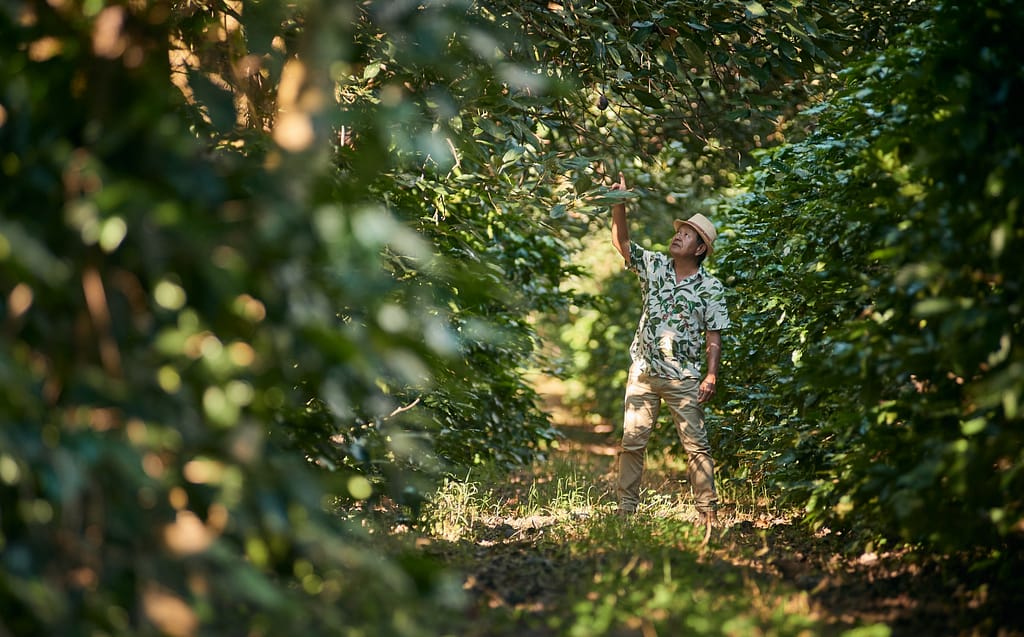[[{“value”:”
Coffee is typically a monoculture crop: most coffee farms grow coffee independently, and intercropping, or growing two or more crops in the same field, is uncommon. But for Getulio Minamihara of Fazenda Minamihara in Franca, São Paulo, Brazil, intercropping transformed his family farm and drastically improved the quality of their coffee.
But the family was hesitant at first. Many believe intercropping is detrimental to quality and common misconceptions, like that intercropping affects production levels and requires more water, have deterred growers from the idea.
However, under Getulio’s stewardship, Fazenda Minamihara has become a pioneer in intercropping. The farm has successfully grown coffee with avocado trees, proving that the two crops can coexist and thrive together.
When Getulio’s father first purchased Fazenda Minamihara in 1973, conventional methods of coffee production were the norm, which included using agrochemicals. Getulio, a trained agronomist, and his wife Clara eventually became involved at the farm quickly after the purchase.
But the family was skeptical of the potential of coffee at all—initially, production levels were low. However, things changed quickly. “In 1975, our harvest was small, but due to a frost in other parts of Brazil, we saw a sharp increase in coffee prices, and our small production became very profitable and helped us solidify our participation in the coffee business,” says Getulio.
The family introduced avocado plants to their farm in 1985. They hoped to diversify their income, protect themselves from the impact of climate events, and eventually shift their income source. “The idea of intercropping was actually to substitute coffee for avocado,” says Getulio.
At first, peers were skeptical of the idea of intercropping coffee and avocados. They assumed that the two crops would compete for water and affect quality, making it difficult to grow them together.
Getulio researched how avocado trees might impact the existing coffee plants. “During this phase, we learned that the avocado’s root system goes deeper than the coffee’s, so the competition for water is very little,” says Getulio.
The family also noticed that many coffee-buying clients were interested in shade-grown coffees, and the avocado plants provided shade to the coffee bushes. “Intercropping was so successful with many benefits that I decided to maintain both cultures,” says Getulio. “And I still have income from two crops.”
The success of intercropping inspired the family to eliminate agrochemicals from their production and harness nature’s power for their benefit.
With his background in agronomy, Getulio understood the importance of biodiversity and soil health and saw the potential to approach farming more sustainably, one that harmonized with nature rather than fighting against it. He observed that conventional farming practices depleted the farm’s soil and made crops more susceptible to pests and diseases.
Over time, watching the crops thrive using intercropping methods made Getulio and his family think more holistically about well-being on the farm. “Ending the use of chemicals and pesticides at our farm shifted the way we see our lives and what we consume,” says Anderson Minamihara, Getulio’s son.
Anderson is in charge of operations at their on-site cafe and noticed that eliminating agrichemicals not only improved their coffee but also gave farmworkers peace of mind. “There was a shift among our workers,” says Anderson, “in the sense that they felt happier and at peace to be working in safer and much more desirable conditions.”
Intercropping creates a more balanced microclimate, says Getulio, who notes that the shade from the avocado trees attracts “more wild animals, bees, and birds.”
The farm’s avocado trees shade the coffee trees, protecting them from intense sunlight. Shade helps regulate temperature and reduces water evaporation, ensuring that both crops receive adequate moisture. Additionally, the leaf litter from the avocado trees adds organic matter to the soil and “greatly improves the soil microbiota, maintains humidity, and reduces weed infestation,” says Getulio. He also says the trees provide respite and shade for coffee workers out on the farm.
Fazenda Minamihara’s intercropping system also helps combat invasive species and pests. The diversity of plants creates a more complex ecosystem that supports beneficial insects and microorganisms. These natural allies help keep pest populations in check, reducing the need for chemical pesticides.
As Getulio fine-tuned his intercropping practices, he noticed that production decreased—but quality increased. “Intercropping greatly improved the quality of our coffees,” he says, but the amount of coffee he produced took a nosedive: productivity dropped 40-50%.
But, he says, he was able to make up for volume loss by pulling in new coffee buyers. “Due to the nutrient enrichment and field protection that avocados provided, we started to produce more exotic and rare coffee varieties that would attract more clientele,” he says. Adding avocados as a source of income also gave more financial stability.
Intercropping coffee and avocado trees at Fazenda Minamihara has brought numerous benefits to the farm and its surrounding environment. The nutrient-rich soil, improved microclimate, and enhanced pest control have led to higher-quality coffee and avocados, diversified the farm’s income, and contributed to the family’s financial stability. Getulio hopes more farmers embrace intercropping and see how plants can work together to build more sustainable systems within coffee farms.
“}]]


